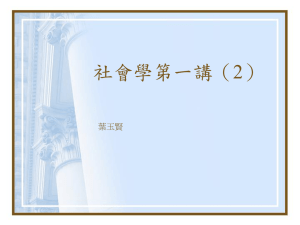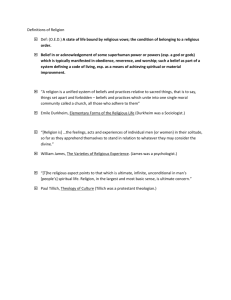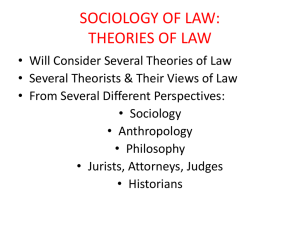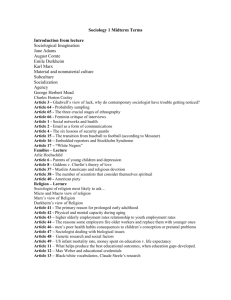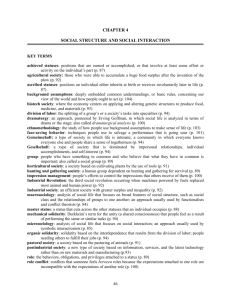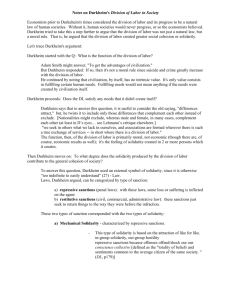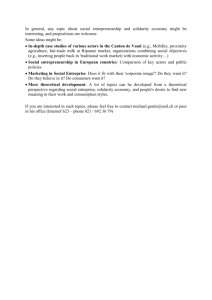Gobitis (1940) & Barnette (1943) SCOTUS Case Analysis
advertisement
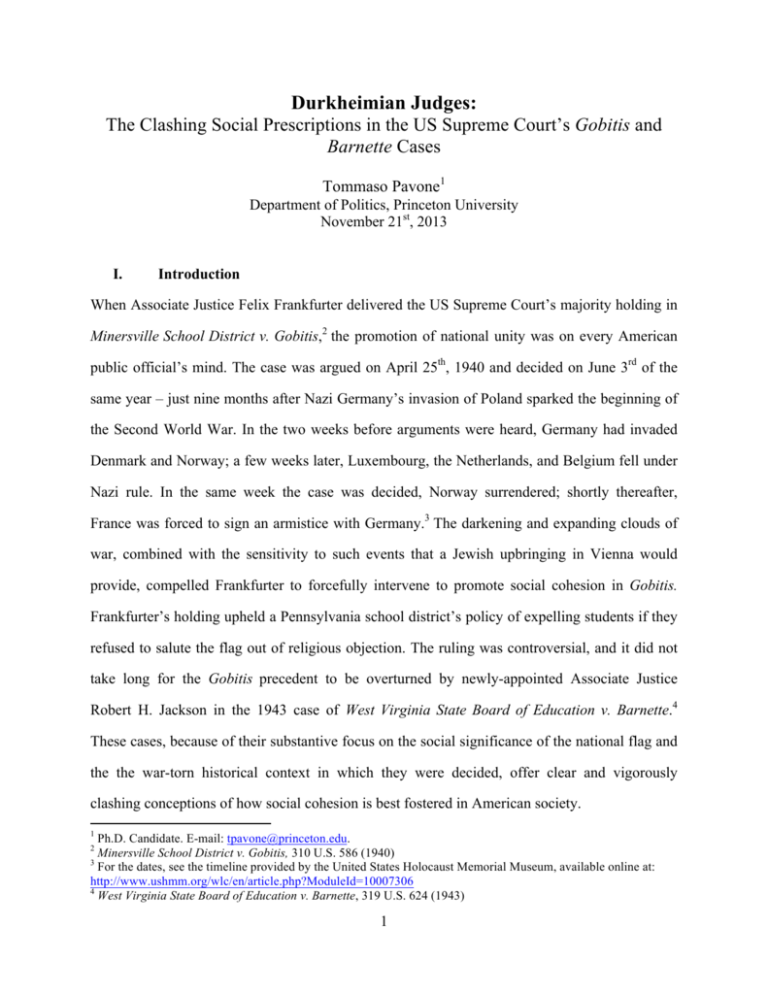
Durkheimian Judges: The Clashing Social Prescriptions in the US Supreme Court’s Gobitis and Barnette Cases Tommaso Pavone1 Department of Politics, Princeton University November 21st, 2013 I. Introduction When Associate Justice Felix Frankfurter delivered the US Supreme Court’s majority holding in Minersville School District v. Gobitis,2 the promotion of national unity was on every American public official’s mind. The case was argued on April 25th, 1940 and decided on June 3rd of the same year – just nine months after Nazi Germany’s invasion of Poland sparked the beginning of the Second World War. In the two weeks before arguments were heard, Germany had invaded Denmark and Norway; a few weeks later, Luxembourg, the Netherlands, and Belgium fell under Nazi rule. In the same week the case was decided, Norway surrendered; shortly thereafter, France was forced to sign an armistice with Germany.3 The darkening and expanding clouds of war, combined with the sensitivity to such events that a Jewish upbringing in Vienna would provide, compelled Frankfurter to forcefully intervene to promote social cohesion in Gobitis. Frankfurter’s holding upheld a Pennsylvania school district’s policy of expelling students if they refused to salute the flag out of religious objection. The ruling was controversial, and it did not take long for the Gobitis precedent to be overturned by newly-appointed Associate Justice Robert H. Jackson in the 1943 case of West Virginia State Board of Education v. Barnette.4 These cases, because of their substantive focus on the social significance of the national flag and the the war-torn historical context in which they were decided, offer clear and vigorously clashing conceptions of how social cohesion is best fostered in American society. 1 Ph.D. Candidate. E-mail: tpavone@princeton.edu. Minersville School District v. Gobitis, 310 U.S. 586 (1940) 3 For the dates, see the timeline provided by the United States Holocaust Memorial Museum, available online at: http://www.ushmm.org/wlc/en/article.php?ModuleId=10007306 4 West Virginia State Board of Education v. Barnette, 319 U.S. 624 (1943) 2 1 The purpose of this essay is to analyze the divergent conceptions of social unity articulated in Gobitis and Barnette through the structural functionalist framework developed by Emile Durkheim, the founder of the French School of Sociology. Like Frankfurter and Jackson, Durkheim was preoccupied with how institutions can further social solidarity. He further developed a dichotomous typology of social solidarity – mechanical solidarity and organic solidarity – and attributed a unique juridical prescription to each type. As will be shown, the Gobitis and Barnette holdings align closely with the sociological conceptualizations and correlative juridical prescriptions of Durkheim’s solidarity typology. Indeed, interpreting both cases via a Durkhemian lens allows us to focus less on their manifest Free Exercise or Free Speech Clause implications and more on their underlying concern with how social unity is best fostered in light of a national security threat. Yet this case study need not limit itself to the mechanical application of Durkheimian heuristics – an opportunity also arises to challenge Durkheim’s own framework. The Gobitis and Barnette cases demonstrate that judges are not unconsciously responding to different social needs, as Durkheim believed. Rather, they expose deliberate judicial attempts to foster social cohesion via divergent means. The objective is therefore to reveal Frankfurter and Jackson as self-consciously Durkheimian figures. II. Durkheim’s Theory of Social Unity To understand how the Gobitis and Barnette decisions can be cast as Durkheimian, it is necessary to briefly revisit Durkheim’s theory of social unity. Much like during the 1940s when Justices Frankfurter and Jackson wrote their opinions, in 1893 when Emile Durkheim published his doctoral dissertation, The Division of Labor in Society, the fabric of society seemed to be under threat. Indeed, the industrialization of European society had sparked increasingly widespread conflicts. In seeking to address these social ailments, Durkheim found existing intellectual paradigms to be unsatisfying. On the one hand, he was opposed to Marxist theory. Marx and Engels predicted that the increasing division of labor accompanying the industrial 2 revolution would alienate human beings from their labor, while their exploitation at the hands of the Bourgeoisie would lay the foundations for a worldwide socialist revolution of workers (see Tucker 1978). This was too radical, conflict-ridden, and turbulent an ideology for Durkheim, who “always conceived of societies as subject to conditions of moral “health” or “illness,” and the sociologist as a kind of “physician” who scientifically determined the particular condition of a particular society at a particular time, and then prescribed the social “medicine” necessary to the maintenance or recovery of well-being” (Jones 1986: 24). On the other hand, Durkheim distanced himself from the works of Adam Smith, whose The Wealth of Nations (1776) he perceived to focus primarily on the economic and material benefits resulting from increased economic specialization. Durkheim believed that such utilitarian and materialist treatments, particularly as expounded by the later work of Jeremy Bentham, lent themselves to an overly atomistic and superficial conceptualization of society. Self-interest, argued Durkheim, did not represent a compelling principle for social organization, for “[s]elf-interest is, in fact, the least constant thing in the world; Today it is useful for me to unite with you; tomorrow the same reason will make me your enemy” (1997 [1893]: 152). He consequently resisted the “cult of the individual” and was an ardent believer that individual autonomy “could only be attained upon secure foundations in conditions of social solidarity firmly binding its members to each other” (Coser 1997: xiii-xiv). Durkheim thus turned to creating his own positivist theory of social unity, complete with correlative legal prescriptions founded on the assumed moral import of social cohesion. Durkheim’s sociological explication of how the division of labor contributes to social solidarity inaugurates the concept of “social function.” To ask what a function is, posits Durkheim, requires one to “investigate the need to which it corresponds” (1997 [1893]: 11). More specifically, for Durkheim an institution’s social function is “the correspondence between it and the needs of the social organism” (Radcliffe-Brown 1935: 394). In contradistinction to economic rationalist theory, his analysis of the division of labor concludes that “the economic 3 services it renders are trivial by comparison with the moral effect it produces. Its true function, the real need to which it corresponds, is that feeling of solidarity in two or more persons which it creates” (Jones 1986). Durkheim concludes that institutional survival is determined by more than is apparent prima facie, namely by the institution’s ability foster solidarity and maintain homeostasis (system stability) (Radcliffe-Brown 1935). To better organize his study of solidarity and endow it with corresponding juridical prescriptions, Durkheim posits that solidarity comes in two distinct types: mechanical solidarity (solidarity in sameness) and organic solidarity (solidarity in difference) (Coser 1997: xvi-xvii). Mechanical solidarity assumes the presence of consensus generating a universally shared norm. This norm’s violation is punished via repressive legal sanctions, which make “demands on [the accused’s] fortune, or on his honor, or his life, or on his liberty, and deprive him of something he enjoys” (1997 [1893]: 69). Conversely, organic solidarity presumes a lack of consensus and the possibility of interdependence via difference, and is consequently characterized by restitutive rules seeking to achieve “only of the return of things as they were, in the re-establishment of troubled relations to their normal state” (1997 [1893]: 69). In short, “[r]epressive laws come into play when deviance is termed a ‘crime’, while restitutive laws set up the moral obligation to recompense claimants who have been injured” (Coser 1997: xvii). Despite his positivist aspirations, Durkheim’s approach clearly has normative undertones: the evolution from mechanical to organic solidarity and from repressive to restitutive law “mark[s] the transition from relatively simple to relatively complex societies” (Coser 1997: xvi). The more diverse and modern a society becomes, the more we see that “repressive law is losing ground” while “restitutory law, which in the beginning did not exist at all, is continually growing” (Durkheim 1997 [1893]: 153). Ultimately, for Durkheim the law signals the type of solidarity present in society – in other words, law and judicial action reflect existing social conditions (see Jones 1986). Thus to differentiate amongst solidarity types it is not enough to “quote a few facts as they occur to one;” rather, one must analyze the “obligations that society imposes upon its 4 members” which, “however slight in importance and duration, take on legal form” (ibid). Note that this view casts judicial action and the development of law as inevitable byproducts of social structure. Having briefly reviewed Durkheim’s structural functionalist theory, the following sections leverage this approach to show how Frankfurter’s Gobitis holding is grounded in a Durkhemian vision of mechanical solidarity whereas Jackson’s Barnette ruling is derived from the concept of organic solidarity. In other words, the cases turn less on how Frankfurter and Jackson interpret the First Amendment and more on what they deem to be the most desirable means to achieve social unity. The cases further expose the deliberate judicial attempts to induce one type of solidarity over the other, thereby contradicting Durkheim’s characterization of judges as unconsciously responding to objectively present forms of social organization and needs. III. Frankfurter’s Gobitis Holding and Mechanical Solidarity The Gobitis case concerned the expulsion of Lillian and William Gobitis (aged twelve and ten, respectively) from their school in Minersville, Pennsylvania, after refusing to partake in the ceremonial salutation of the national flag.5 The Gobitis family was affiliated with Jenovah’s Witnesses, and consequently Lillian and William were taught that the Bible is the supreme authority and that gesturing respect for the flag was forbidden by scripture.6 Their father sued to allow for his children’s return to school (without being compelled to salute the flag) and to seek financial recompense for the costs incurred by having to send his children to private school following their expulsion.7 The question before the Court concerned whether the school district’s expulsion violated Lillian and William Gobitis’ First Amendment rights enshrined in the Free Exercise Clause.8 5 310 U.S. 586 (1940) at 591. Ibid, at 591-592. 7 Ibid. 8 Ibid, at 593. 6 5 Justice Frankfurter upheld the School district’s expulsion. His argument commences by noting that “to affirm that the freedom to follow conscience has itself no limits in the life of society would deny that very plurality of principles which, as a matter of history, underlies protection of religious toleration.”9 In so doing, Frankfurter begins to construct the notion that a consensus exists in American society, as embodied in American tradition, regarding when limiting religious freedom is appropriate. Citing precedent where the Court upheld legislation in Free Exercise Clause cases, Frankfurter notes that the statutes or policies in question were “deemed by the legislature essential to secure and maintain that orderly, tranquil, and free society without which religious toleration itself is unattainable.”10 Although Frankfurter acknowledges that there exists no “logical talisman”11 that can resolve conflicts between individual religious liberty and national unity, he ultimately sides with the latter by employing fundamentally Durkhemian logic. Durkheim believed that because an individual’s autonomous self-fulfillment “presuppose[s] social order, [it] cannot serve as its foundation. The social order has primacy over individually motivated action.” (Coser 1997: xv). Frankfurter makes his argument in parallel form: “The ultimate foundation of a free society is the binding tie of cohesive sentiment. Such a sentiment is fostered by all those agencies of the mind and spirit which may serve to gather up the traditions of a people, transmit them from generation to generation, and thereby create the continuity of a treasured common life which constitutes a civilization. “We live by symbols.” The flag is the symbol of our national unity, transcending all internal differences, however large, within the framework of the Constitution […] the flag is the symbol of the nation’s power – the emblem of freedom in its truest, best sense […] indeed the enjoyment of all freedom, presuppose[s] the kind of ordered society which is summarized by our flag.”12 Ultimately, Frankfurter concluded that “it mocks reason and denies our whole history to find in the allowance of a requirement to salute our flag on fitting occasions the seeds of sanction for 9 Ibid, at 594. Ibid, at 595. 11 Ibid, at 596. 12 Ibid, at 596; 600. 10 6 obeisance to a leader.”13 By siding with social cohesion in a constitutional matchup against individual religious expression, and by holding that alternative conceptions of the flag “[mock] reason and [deny]” American tradition, Frankfurter assumes (indeed, constructs) the presence of mechanical solidarity – a social consensus regarding the flag’s social meaning. And, just as Durkheim would predict, Frankfurter’s juridical remedy is subsequently repressive: the Gobitis family is denied the restitutive remedy it sought, and the school district’s expulsion policy is held to comply with the Free Exercise Clause. Had Durkheim been analyzing the Gobitis case, he may well have interpreted it as signaling the presence of mechanical solidarity. That is where his theory goes astray. By denying the capability of Frankfurter to construct his own subjective notion of social consensus surround the flag, Durkheim’s framework would wrongly cast the Gobitis holding as inevitable – as objectively fulfilling a social need unbeknownst to Frankfurter himself. Nothing serves as a better refutation of this interpretation than Justice Jackson’s 1943 Barnette holding overturning the Gobitis precedent – for could it really be contended that, within the span of three short years, the type of social solidarity existing in the United States had fundamentally changed? IV. Jackson’s Barnette Holding and Organic Solidarity Associate Justice Jackson’s holding in West Virginia State Board of Education v. Barnette delivers an exceptionally vigorous refutation of Frankfurter’s ruling in Gobitis, yet the facts of the cases are almost identical. In response to the Gobitis decision, in 1942 the West Virginia State Board of Education adopted a resolution rendering the salutation of the flag compulsory in public schools.14 Failure to salute the flag would be considered insubordination punishable by expulsion. 15 Additionally, such compelled absence from public school would be deemed unlawful, rendering the children’s parents vulnerable to prosecution.16 Once again, children who 13 Ibid, at 598. 319 U.S. 624 (1943), at 625-626. 15 Ibid, at 629. 16 Ibid. 14 7 were members of Jenovah’s witnesses refused to salute the flag and were subsequently expelled. In this case, the parents of two expelled children, the Barnettes, brought suit in Federal District Court, and the case eventually climbed its way to the Supreme Court. Justice Jackson’s holding immediately strikes a different tone from Frankfurters’ – its emphasis is not on assumed consensus, but on its mandated and problematic creation: “Here, however, we are dealing with a compulsion of students to declare a belief.”17 Instead of being assumed away, the presence of legitimate dissent is validated. Jackson then addresses the vision of mechanical solidarity articulated in Gobitis. Just as Durkheim believed that mechanical solidarity is characteristic of less advanced societies, so too does Jackson declare that “symbolism is a primitive but effective way of communicating ideas.”18 But he goes further: “The use of an emblem or flag to symbolize some system, idea, institution, or personality, is a short cut from mind to mind […] Causes and nations […] seek to knight the loyalty of their followings to a flag or banner, a color or design.”19 Nevertheless, “[a] person gets from a symbol the meaning he puts into it, and what is one man’s comfort and inspiration is another’s jest and scorn.”20 In other words, one cannot assume the universal social significance of the flag. Rather, its imbuement with meaning can effectively be constructed and subsequently leveraged as a tool of social reform. To assume the presence of consensus and the legitimacy of its coercive maintenance at the hands of government is, in Jackson’s mind, Frankfuter’s crucial error: “[t]he Gobitis decision,” Jackson writes, “assumed, as did the argument in that case and in this, that power exists in the State to impose the flag salute.”21 In the end, Jackson declares the compelled salutation of the flag in public schools to be in violation of the First Amendment’s Free Speech Clause, for it amounts to the unconstitutional compulsion of speech. The American people, argues Jackson, do not hold homogenous views 17 Ibid, at 631. Ibid at 632. 19 Ibid, at 632. 20 Ibid at 633. 21 Ibid, at 635. 18 8 regarding the social meaning of the flag, and the United States’ constitutional tradition is meant to safeguard the very heterogeneity of opinion represented in the refusal to salute the national flag: “Here it is the State that employs a flag as a symbol of adherence to government as presently organized. It requires the individual to communicate by word and sign his acceptance of the political ideas it thus bespeaks. Objection to this form of communication when coerced is an old one, well known to the framers of the Bill of Rights […] To enforce those rights [to refuse to salute the flag] today is not to choose weak government over strong government. It is only to adhere as a means of strength to individual freedom of mind in preference to officially disciplined uniformity for which history indicates a disappointing and disastrous end […] we apply the limitations of the Constitution with no fear that freedom to be intellectually and spiritually diverse or even contrary will disintegrate the social organization. To believe that patriotism will not flourish if patriotic ceremonies are voluntary and spontaneous instead of a compulsory routine is to make an unflattering estimate of the appeal of our institutions to free minds.”22 As a result, and in line with Durkheim’s juridical prescriptions, Jackson nullifies the repressive sanctions validated by Gobitis in favor of restitutive action: the Barnettes, and other children like them, must be allowed to return to school, and their right to refuse to salute the flag must be protected. And just to render his total repudiation of Frankfurter’s Gobitis holding crystal clear, Jackson delivers the following scathing pronouncement: “Those who begin coercive elimination of dissent soon find themselves exterminating dissenters. Compulsory unification of opinion achieves only the unanimity of the graveyard.”23 There can be no more forceful defense of organic solidarity, no more vigorous refutation of the judicial sponsorship of the repressive compulsion of mechanical social unity, than the sentiment captured by these blistering words. Unsurprisingly given the historical context, Frankfurter took the attack to heart. “One who belongs to the most vilified and persecuted minority in history,” he retorted in his dissent, “is not likely to be insensible to the freedoms guaranteed by our Constitution.”24 22 Ibid, at 633; 637; 641. Ibid, at 641. 24 Ibid, at 646. 23 9 V. Durkheimian Judges There is little doubt that American society, and the character of its solidarity, did not radically evolve between 1940 and 1943 – what changed was the composition of the Court and the ideological predispositions of its members. More specifically, what differed was what Frankfurter and Jackson perceived to be the appropriate judicial interventions to achieve social cohesion. In this view, judges are not unconsciously reacting to social needs. Durkheim’s analysis of restitutive and repressive laws rested on this assumption, namely that “although society is nothing without individuals, each one of them is more a product of society than he is the author” (1997 [1893]: 288). This is fallacious: Frankfurter and Jackson were, in their own way, attempting to foster particular types of social unity – the former a vision of unity in consensus, the latter a vision of unity in diversity. As a result, court rulings cannot be assumed to be mere signals of the types of solidarity present in society. In these cases, they primarily represent deliberate attempts by officials in position of power to nudge the character of society in a particular direction. To characterize the holdings of Frankfurter and Jackson as derivative of social conditions ignores the constructed nature of the premises and objectives upon which both decisions rest, thereby absolving their respective authors of any responsibility in the process. If this is so, how are Frankfuter and Jackson in any sense “Durkheimian”? The key is to endogenize Durkheim and see how his own preoccupations and social prescriptions are reproduced in the Gobitis and Barnette decisions. As highlighted earlier, Durkheim saw himself as a social physician, and indeed his scholarship “was intended to prepare the ground for active social intervention” (Coser 1997: xiii). In parallel form, the holdings of Frankfurter and Jackson highlight the fact that judges can similarly view themselves as proactive social doctors. Both begin by constructing a vision of American society; they subsequently formulate a diagnosis that they ultimately leverage to justify their socio-constitutional prescriptions. In short, while Durkheim’s logic does not explicate the social function of judges in any objective sense, it gains far better leverage in helping us understand the subjective psyche of the judges themselves – in 10 explicating the ways judges conceive of their own duty to society. What ultimately reproduces Durkheim’s prescriptive logic in the holdings of Frankfurter and Jackson is their common preoccupation with protecting the integrity of the social fabric, a fabric that serves as nothing less than the repository of their deepest social, moral, and ideological convictions. 11 VI. Works Cited Coser, Lewis. 1997. “Introduction.” In The Division of Labor in Society (Emile Durkheim, auth.). New York, NY: The Free Press. Durkheim, Emile. 1997 [1893]. The Division of Labor in Society. New York, NY: The Free Press. Jones, Robert A. 1986. Emile Durkheim: An Introduction to Four Major Works. Beverly Hills, CA: Sage Publications. Radcliffe-Brown, Alfred. 1935. “On the Concept of Function in Social Science.” American Anthropologist, 37 (3): 394-402. Smith, Adam. 2009 [1776]. The Wealth of Nations. Blacksburg, VA: Thrifty Books. Tucker, Robert C. 1978. The Marx-Engels Reader. New York, NY: W. W. Norton & Company. VII. Supreme Court Cases Cited Minersville School District v. Gobitis, 310 U.S. 586 (1940) West Virginia State Board of Education v. Barnette, 319 U.S. 624 (1943) 12
